1960 Italian Grand Prix race report: Monza red again at long last
Phil Hill secures Ferrari's first Italian Grand Prix win for eight years as Scuderia secures 1-2-3; British teams pull out in protest at use of banking
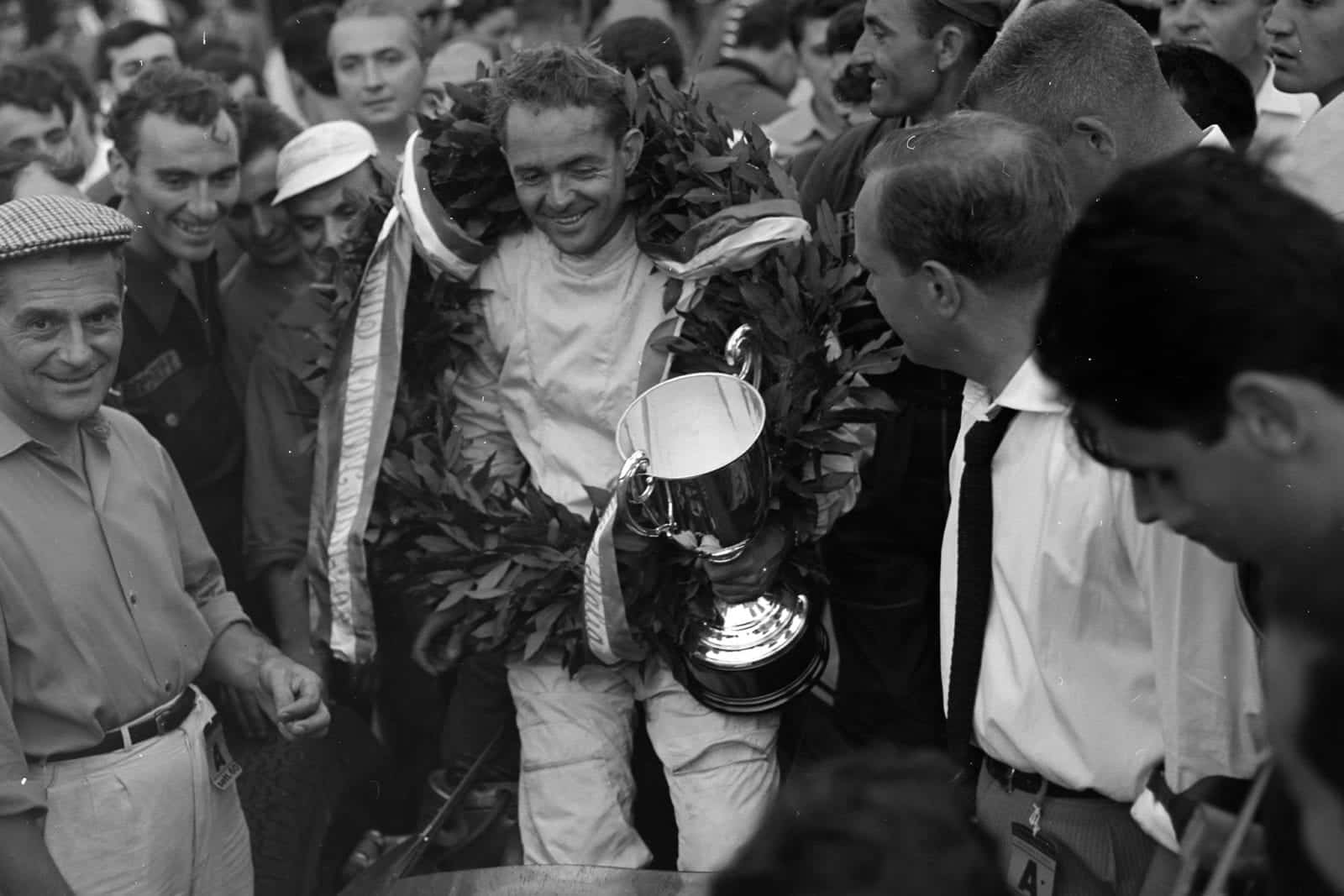
Phil Hill takes the plaudits upon winning Ferrari's home race
Motorsport Images
This year the Italian Grand Prix took the title of the Grand Prix of Europe, for what it is worth, and the organisers reverted to the to-kilometre combined road and banked track circuit at Monza, which was used in 1955 and 1956. In this arrangement the wide part of the track in front of the pits and grandstands is divided into two lanes by conical rubber markers, carrying BF advertising, and the start is on the outer lane, away from the pits.
From here the course follows the normal road circuit via the Curva Grande to the two sharp right-hand bends at Lesmo, back around the Ascari curve and down the back straight to the Curva Sud. This brings the course onto the inside of the pits straight where it runs parallel with the starting straight until it runs onto the northern banking in a right-handed sweep.

Banking returned to the Monza configuration for the time in four years
Motorsport Images
The banked track passes over the road circuit return leg and then down a straight parallel with the other two straights of the road circuit, and onto the south banking. From this banking the course runs onto the pits straight on the outside and back to the start. This layout results in cars travelling at maximum speed off the south banking and past the grandstands, while on the inside are cars still accelerating from the fiat Curva Sud; it also means that any visits to the pits must be made at the half lap, while travelling up the pits side of the wide straight.
In 1955 on this circuit Fangio won with a Mercedes-Benz over a distance of 500 kilometres at an average of 206.791kph after the German firm had done a lot of testing and applied a lot of science to the suspension geometry and travel in order to adapt the car to the high speed banking. In 1956 Moss won the race over the same distance at an average of 208.787kph in a brand new 250F Maserati that merely had blocks under the springs to raise the car slightly to avoid the sump grounding over the bumps on the banking.
One of the biggest problems to adjusting a car to suit the road-and-track circuit is the question of tyres, for tread patterns and pressures suitable for the road circuit are impossible for the banked track and vice-versa, and while everything about a racing car must of necessity be a compromise, this problem stretches the compromise a bit near the limit as far as tyres are concerned. Whereas the normal road-racing tyre will comfortably run a 300-mile Grand Prix on the average circuit, there was no hope of this on the Monza to-kilometre circuit, so that pit stops for tyre changing were going to be essential.
Since 1956 the Grand Prix scene has changed considerably and whereas then there were teams of Ferrari, Maserati, Vanwall, Connaught and Gordini and they all entered the race and set about adjusting their cars accordingly, this year saw only Ferrari ready to enter, the others mentioned having withdrawn from racing long since. The replacements in the shape of Lotus, Cooper and BRM were not interested in competing on the road and-track circuit and instead of saying so politely and simply, they got together and tried to use strong arm tactics, saying “Unless the Italian GP is run on the road circuit only we will not enter”, to which the AC of Italy replied “All right, don’t enter,” and they didn’t.
“Lotus, Cooper and BRM said ‘Unless the Italian GP is run on the road circuit only we will not enter’, to which the AC of Italy replied ‘All right, don’t enter’, and they didn’t”
The result was an entry of 18 ears scraped up by various means and the Italian GP was held over the full 500 kilometres (300 miles) on the road-and-track circuit and everyone was happy, except the English. In order to swell the ranks the ACI opened the race to F1 and F2 cars so that Ferrari and Porsche were both quick to take advantage of a chance to match their cars against known conditions and get some experience in readiness for the 1961 season of F1 racing to the new 1.5-litre Formula.
The Scuderia Ferrari now enter their cars under the initials SEFAC which stand for the official legal title of the Ferrari factory since it was made a public company, and there were three F1 front-engined V6 Dino 246 cars to be driven by Phil Hill, Ginther and Mairesse, the one driven by Ginther having a slightly longer wheelbase. The F2 rear-engined V6 Dino 156 car that trounced Porsches at Solitude was entered to be driven by von Trips and these four were naturally the mainstay of the entry.

Horace Gould’s Maserati 250F in the paddock
Motorsport Images
A week before the race Ferrari tried out a new F1 rear-engined car, which was very satisfactory, but with no opposition in the Grand Prix there was no point in running it. Added to which was the question of who should have driven it. With the Porsche factory entering two works F2 cars driven by Herrmann and Barth it seemed only reasonable to match von Trips against them and make it an all-German F2 contest. The Porsches were the normal 1960 cars and there was a third Porsche, this being the ex-Behra Colotti Special which Camoradi were in the process of selling to Ray Colet, a young American, so the Camoradi driver Fred Gamble drove it.
The Scuderia Eugenio Castellotti entered their two Cooper-Ferraris, which are 1959 type Cooper chassis with four-cylinder Ferrari engines derived from the old SuperSqualo Ferraris, and having Colotti five-speed gearboxes. These two cars were driven by Cabianca and Munaron as the whole object of the Scuderia is to provide cars for Italian drivers as Ferrari seems reluctant to do so.
The other Italian Scuderia, the Centro-Sud, whose aim is to give new drivers a chance to get into F1 when possible, entered their two Cooper-Maserati cars with Scarlatti and Alfonso Thiele as drivers, the latter being new to single-seater racing though having a great deal of experience of Monza with GT Ferraris and Abarth record breakers.
The rest of the field was made up by private owners, there being Naylor with his JBW Maserati, Arthur Owen with his 2.2-litre Cooper-Climax painted green for the occasion, and Gould reappeared with his old 250F Maserati. Then there were some private F2 entries to complete the list, Seidel with his Coope-rClimax, though he entered a Porsche F2 as well but it did not materialise, and Piero Drogo with the Cooper-Climax owned by von Trips and his Scuderia Colonia, and finally Wilson with Gibson’s Cooper-Climax.
Qualifying
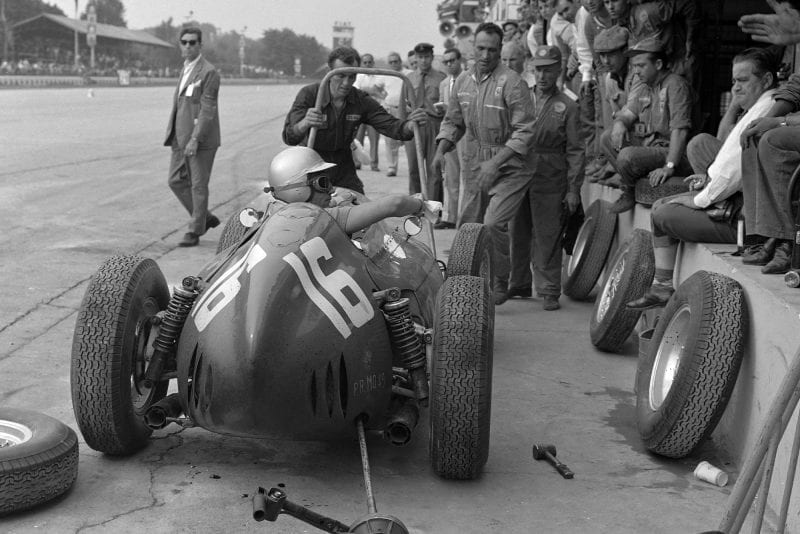
Mairesse’s Ferrari pays a visit to the pits
Motorsport Images
As can be imagined practise was not very eventful and the results of the two training periods, on Friday and Saturday, were easy to imagine, the only bright spot being the way the F1 Ferraris helped their F2 cars along by slip-streaming so that they were easily faster than the Porsches and the Stuttgart people were leaping up and down because nobody would give them a tow. The Centro-Sud cars did not practise until the second day and neither did Naylor, while Gould did not practise at all as he could not get his Maserati to start, so was posted a non-starter.
“Undoubtedly the high spot of the Saturday practice was when Enzo Ferrari himself was forcibly ejected off the pit area because he did not have a pass by an excited policeman”
Naturally the three F1 Ferraris were the fastest in order of driving ability, while Centro-Sud and the Castellotti cars had a private battle for the second row of the grid, ending up one each. Undoubtedly the high spot of the Saturday practice was when Enzo Ferrari himself was forcibly ejected off the pit area because he did not have a pass, by an excited policeman. There was quite an uproar and the Ferrari cars returned to practise only after many apologies from high officials. The policeman in question was said to have been last seen sitting in his own gaol, only on the wrong side of the bars!
Race
Sunday was not a bright day for the spectators, and there was as big a crowd as at any Monza race recently, but it was ideal for the drivers, being absolutely dry with a cool breeze and clouded skies. Altogether 16 cars lined up on the grid as follows, in rows of three-two-three instead of the usual four-three-four, as only half the track width was being used.
When the flag fell 14 cars shot off to begin the 50 laps of the race and Cabianca and Munaron were both left behind, having stalled the Ferarri engines in their Coopers; mechanics push-started them and they set off after the rest of the field which were streaming into Lesmo.
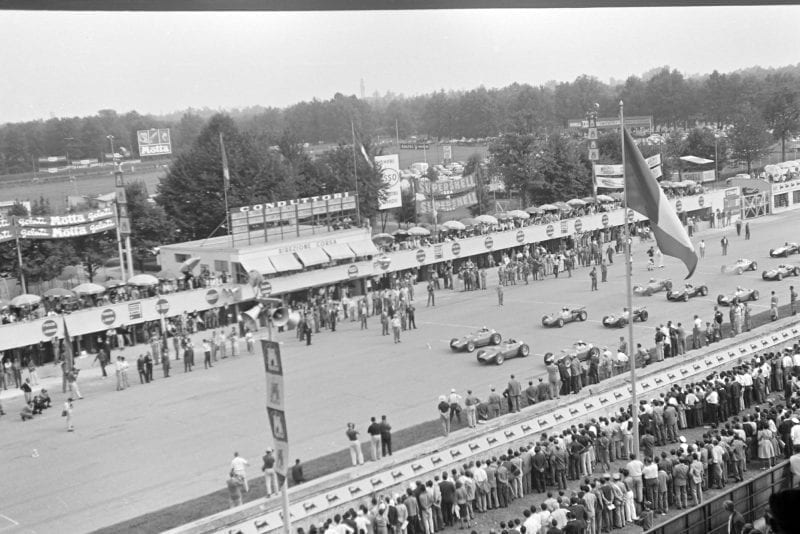
The field sprints away at the start
Motorsport Images
As the cars came by the pits at the end of the half lap Ginther was leading Phil Hill, as arranged, and third was Scarlatti in the Centro-Sud Cooper-Maserati, followed by Mairesse who was visibly slowing down and waiting for von Trips who was stuck behind the two works Porsches. Already Munaron had caught three of the private F2 cars and Cabianca was gaining ground rapidly, but Owen was missing having crashed on the South corner seemingly through lack of brakes, he being thrown out unhurt but his car being bent in all directions.
Round the banked track the 15 cars went with Ginther and Hill pulling away from the rest and Mairesse still waiting for von Trips, so that Naylor moved up into fourth place. For once the Ferrari team were working to a plan, decided the night before, that the two Americans should go on ahead while the Belgian driver hung back and towed the F2 Ferrari along into slip-stream. Then at half distance Ginther and Mairesse should change places and Phil Hill should lead, Ginther towing the F2 car while Mairesse made up ground and any places he might have lost whilst towing the F2 car.
If all went well this would result in Ferraris 1-2-3-4. The works Porsches must have known this but probably didn’t believe that the Ferrari team would work together. However, on the second lap von Trips got in front of Herrmann and Barth, and there was Mairesse dutifully soft-pedalling and waiting for him and away they went.
“For once the Ferrari team were working to a plan, decided the night before”
For half a lap the two Porsches hung on but then they got out of the slip-stream and Mairesse and von Trips disappeared into the middle distance, leaving the Porsche pit steaming with rage. On the fourth lap Scarlatti stopped at the pits with accelerator pedal trouble and Mairesse and von Trips sailed past Naylor, as did Munaron in the Cooper-Ferrari after he had overtaken the two Porsches which were travelling one behind the other.
This put Ferraris 1-2-3-4, followed by Munaron, Naylor, Herrmann, Barth and Cabianca and on lap five Cabianca passed the two Porsches but they did not get into his slip-stream and were left behind on their own. Munaron now upset the Ferrari plan for he overtook Mairesse and von Trips and took third place but the three of them stayed very close together and by the next lap Cabianca was up with them. On lap seven he passed them all and took third place and drew away, while Mairesse did his best to deal with Munaron without dropping von Trips from his slip-stream, and meanwhile Ginther, who was to lead until half-distance, and Hill were lapping the tail-enders, and Scarlatti was back in the race, but a lap behind after another pit stop to cure his accelerator pedal trouble.
By lap 10 Ginther and Hill were 1sec, apart and 75sec ahead of Cabianca who was 9sec ahead of Mairesse and von Trips who still had Munaron with them. Poor Mairesse was suffering having to watch the Cooper-Ferrari draw away in front while he had to hang back and set the F2 pace for von Trips, but it was definitely paying off for the two Porsches were Way behind and had let another F1 car go by, when Thiele moved up into eighth place. Already lapped were Drogo, Seidel, Gamble, Scarlatti and Wilson in that order, and Seidel and Gamble were having a splendid race with each other, changing places frequently.
On lap 13 Cabianca was lapping Scarlatti, who had been delayed at the pits and they went onto the north banking together, but at the end of the south banking Cabianca had gained a considerable lead, indicating that the four-cylinder Ferrari engine propelled a Cooper chassis faster than did a four-cylinder Maserati engine, but by the time they had completed the road circuit they were together again, which rather looked as if Scarlatti was the better driver of the two.
At 16 laps Munaron caused an embarrassment by getting between Mairesse and von Trips and so the Belgian had to ease off and let the Cooper-Ferrari go on into fourth place. At 16 laps Ginther came into the pits as arranged and in very quick time had both rear wheels changed and was back in the race in second place, but only for a lap as next time round Hill was into the pits and he had both rear wheels changed and also the front right-hand one, so that when things settled down again Ginther was leading Hill by 25sec, the added time taken to change Hill’s front tyre plus a bit that he lost in stalling his engine when restarting after his pit stop.
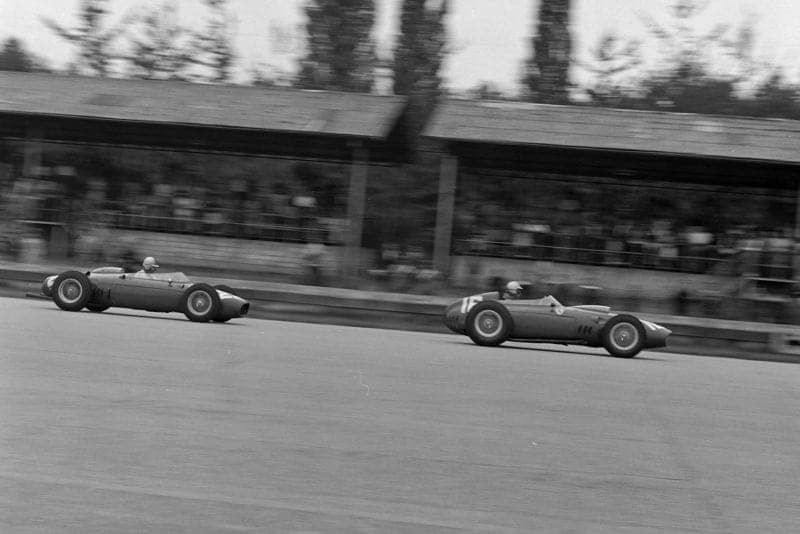
Mairesse leads von Trips in their dice for 5th
Motorsport Images
By now the leader was not far off lapping von Trips, who was in fifth place, everyone else having been lapped, and it was Mairesse’s turn for a pit stop so for a lap he drew ahead of von Trips and then pulled into the Ferrari pit to have both rear wheels and the offside front wheel changed. This was on lap 201 and it left the F2 Ferrari all on its own but it was well ahead of the two Porsches, which were still nose to tail and changing places occasionally.
On lap 21 the order was Ginther, Hill, Cabianca, Munaron and von Trips, all on the same lap, then Naylor Thiele, Barth, Herrmann and Mairesse. On the next lap Cabianca stopped for fuel and rear wheels, the Cooper bolt-on wheels taking an awful long time to change and Mairesse whistled past the two Porsches, not waiting to give them a tow needless to say. On lap 23 Ginther lapped von Trips and eased off so that the rear-engined F2 Ferrari could tuck in behind and this let Hill close up ready to take the lead at half distance, so that the Ferrari plan was working admirably.
On this lap Munaron stopped for fuel and one rear tyre and at 25 laps, or half distance the order was Ginther, Hill, von Trips one whole lap behind Ginther, then Naylor who had been running a splendidly regular race and was now profiting from it and he was followed by Mairesse who was ahead of the two Porsches, but they had Cabianca now closing up rapidly on them. Scarlatti had worked his way up into ninth place, but now stopped for fuel and the three private F2 cars were still mixing at the back of the field, though with Drogo always leading.
So far there had only been one more retirement, that being Wilson with Gibson’s F2 Cooper, but within the next eight laps three cars suddenly went out, Munaron with a broken oil pipe, and the two Cooper-Maseratis of Thiele and Scarlatti. On lap 26 Phil Hill went into the lead and Ginther continued to tow the F2 car, even though it was a lap behind him, as was Mairesse in fourth place, who was catching them up.
However, Cabianca was also gaining ground steadily and at 28 laps as they came up past the pits Ginther expected Mairesse to take over the F2 car but instead he went straight on by, having had enough of soft-pedalling and being passed by Cooper-Ferraris. As all three went onto the north banking Ginther really opened out and went by Mairesse and poor von Trips was left all on his own again, for neither of them waited for him now. Ginther could only assume that Mairesse was a lap behind him, but he was all for not raking chances and pressed off after Hill who was comfortably out in front.
At 32 laps Ginther was in again for more tyres, and at 33 laps Barth came in to refuel his Porsche, no tyre changing being necessary for the F2 cars. Their stop was pretty quick and did not lose him a place and two laps later Herrmann stopped for fuel and the pit staff were even quicker. On lap 35 Hill also came in to have his left-hand tyres changed in a very slick bit of pit work on the part of the Ferrari mechanics so that he restarted still in the lead, and on the next lap Mairesse was also in for his second tyre change.
Naylor stopped for fuel as did Gamble, the Behra-Porsche not having as big a tank as was reckoned, but not long after restarting they both ran into trouble. Naylor’s JBW-Maserati had gone perfectly up till now and he was a steady fifth, only losing this place to Cabianca when he stopped for fuel, only seven laps later his-five-speed Maserati gearbox broke and he was out of the race with only nine laps to go. Gamble had taken on a churn of fuel, expecting it to be enough but on lap 40 he came to rest at the south turn with the fuel pumps ticking, for though there was fuel in the tank, there was not sufficient head for the pumps to pick-up properly. While the race drew to a close he ran back to the pits for a can of fuel, went back to the car and got going again just in time to be flagged in a finisher.
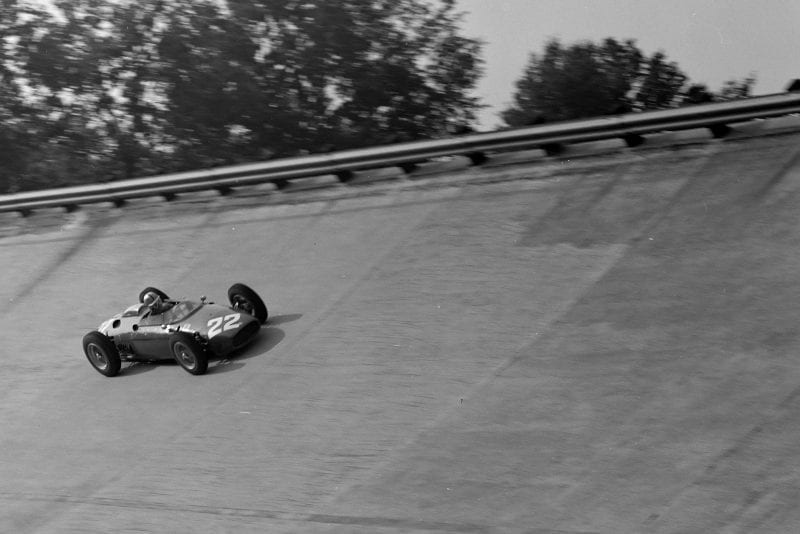
Von Trips eventually finished 5th in the front-engined Ferrari
Motorsport Images
Mean while the pits were still very busy for on lap 38 Drogo had at last stopped for fuel in the white Colonia Cooper-Climax and on lap 39 von Trips had stopped so that Dunlop could look at his rear tyres; they were not too worn so off he went again, but this brief stop had let Cabianca go by into fourth place, thus spoiling the Ferrari display. As the rear-engined F2 Ferrari went the whole distance without refuelling it was a pity that its run was spoilt by an indecision over tyres. At 42 laps Mairesse stopped unexpectedly to tell about horrid noises in the transmission but he was sent out to finish one lap behind Phil Hill.
“Hill became the first American to win a proper Grand Prix in Europe since Jimmy Murphy way back in the dark ages”
The number one American road racer completed the 50 laps at a new record race average and thus became the first American to win a proper Grand Prix in Europe since Jimmy Murphy way back in the dark ages. Ginther was a worthy second followed by Mairesse, Cabianca who had driven most determinedly and spoilt the Scuderia Ferrari clean sweep, and von Trips who was first of the F2 category. A lap later came the two works Porsches and in true German fashion showing perfect team discipline they crossed the line in an apparent dead-heat though Herrmann was given the verdict. Finally came three private F2 cars led by Drogo who had driven a very good race for his first try at Grand Prix racing, and then Seidel and Gamble.
